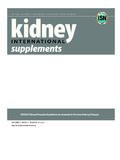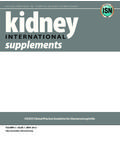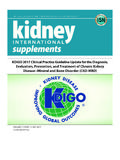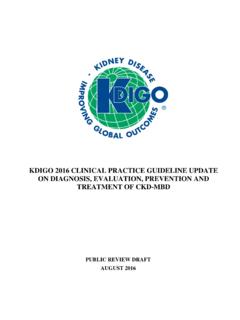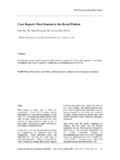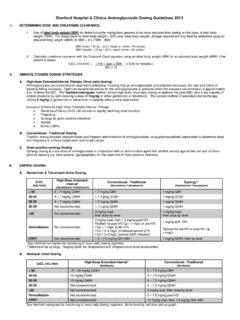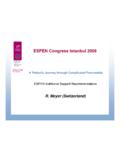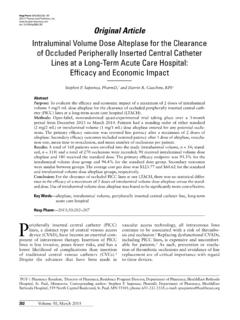Transcription of KDIGO Clinical Practice Guideline for Acute Kidney …
1 OFFICIAL JOURNAL OF THE INTERNATIONAL SOCIETY OF NEPHROLOGY. KDIGO Clinical Practice Guideline for Acute Kidney injury VOLUME 2 | ISSUE 1 | MARCH 2012. 1 2/7/12 12:32 PM. contents & 2012 KDIGO . VOL 2 | SUPPLEMENT 1 | MARCH 2012. KDIGO Clinical Practice Guideline for Acute Kidney injury iv Tables and Figures 1 Notice 2 Work Group Membership 3 KDIGO Board Members 4 Reference Keys 5 Abbreviations and Acronyms 6 Abstract 7 Foreword 8 Summary of Recommendation Statements 13 Section 1: Introduction and Methodology 13 Chapter : Introduction 17 Chapter : Methodology 19 Section 2: AKI Definition 19 Chapter : Definition and classification of AKI. 23 Chapter : Risk assessment 25 Chapter : Evaluation and general management of patients with and at risk for AKI.
2 28 Chapter : Clinical applications 33 Chapter : Diagnostic approach to alterations in Kidney function and structure 37 Section 3: Prevention and Treatment of AKI. 37 Chapter : Hemodynamic monitoring and support for prevention and management of AKI. 42 Chapter : General supportive management of patients with AKI, including management of complications 43 Chapter : Glycemic control and nutritional support 47 Chapter : The use of diuretics in AKI. 50 Chapter : Vasodilator therapy: dopamine, fenoldopam, and natriuretic peptides 57 Chapter : Growth factor intervention 59 Chapter : Adenosine receptor antagonists 61 Chapter : Prevention of aminoglycoside- and amphotericin-related AKI.
3 66 Chapter : Other methods of prevention of AKI in the critically ill 69 Section 4: Contrast-induced AKI. 69 Chapter : Contrast-induced AKI: definition, epidemiology, and prognosis 72 Chapter : Assessment of the population at risk for CI-AKI. 76 Chapter : Nonpharmacological prevention strategies of CI-AKI. 80 Chapter : Pharmacological prevention strategies of CI-AKI. 87 Chapter : Effects of hemodialysis or hemofiltration 89 Section 5: Dialysis Interventions for Treatment of AKI. 89 Chapter : Timing of renal replacement therapy in AKI. 93 Chapter : Criteria for stopping renal replacement therapy in AKI. 95 Chapter : Anticoagulation 101 Chapter : Vascular access for renal replacement therapy in AKI.
4 105 Chapter : Dialyzer membranes for renal replacement therapy in AKI. 107 Chapter : Modality of renal replacement therapy for patients with AKI. 111 Chapter : Buffer solutions for renal replacement therapy in patients with AKI. 113 Chapter : Dose of renal replacement therapy in AKI. 116 Biographic and Disclosure Information 122 Acknowledgments 124 References contents & 2012 KDIGO . TABLES. 18 Table 1. Implications of the strength of a recommendation 19 Table 2. Staging of AKI. 21 Table 3. Comparison of RIFLE and AKIN criteria for diagnosis and classification of AKI. 21 Table 4. Cross-tabulation of patients classified by RIFLE vs. AKIN. 22 Table 5. Causes of AKI and diagnostic tests 23 Table 6.
5 Causes of AKI: exposures and susceptibilities for non-specific AKI. 28 Table 7. AKI diagnosis 29 Table 8. Overview of the approaches to determine baseline SCr in the application of RIFLE classification in previous studies 29 Table 9. Estimated baseline SCr 30 Table 10. AKI staging 33 Table 11. Definitions of AKI, CKD, and AKD. 33 Table 12. Examples of AKI, CKD, and AKD based on GFR and increases in SCr 35 Table 13. Markers of Kidney damage in AKD and CKD. 35 Table 14. Integrated approach to interpret measures of Kidney function and structure for diagnosis of AKI, AKD, and CKD. 73 Table 15. CI-AKI risk-scoring model for percutaneous coronary intervention 77 Table 16.
6 Additional radiological measures to reduce CI-AKI. 91 Table 17. Potential applications for RRT. 91 Table 18. Fluid overload and outcome in critically ill children with AKI. 97 Table 19. Overview of the advantages and disadvantages of different anticoagulants in AKI patients 104 Table 20. Catheter and patient sizes 107 Table 21. Typical setting of different RRT modalities for AKI (for 70-kg patient). 108 Table 22. Theoretical advantages and disadvantages of CRRT, IHD, SLED, and PD. 112 Table 23. Microbiological quality standards of different regulatory agencies FIGURES. 14 Figure 1. The RIFLE criteria for AKI. 20 Figure 2. Overview of AKI, CKD, and AKD. 20 Figure 3.
7 Conceptual model for AKI. 25 Figure 4. Stage-based management of AKI. 26 Figure 5. Evaluation of AKI according to the stage and cause 34 Figure 6. Chronic Kidney Disease Epidemiology Collaboration cohort changes in eGFR and final eGFR corresponding to KDIGO definition and stages of AKI. 34 Figure 7. GFR/SCr algorithm 38 Figure 8. Conceptual model for development and Clinical course of AKI. 48 Figure 9. Effect of furosemide vs. control on all-cause mortality 48 Figure 10. Effect of furosemide vs. control on need for RRT. 51 Figure 11. Effect of low-dose dopamine on mortality 52 Figure 12. Effect of low-dose dopamine on need for RRT. 73 Figure 13. Sample questionnaire 78 Figure 14.
8 Risk for contrast-induced nephropathy 81 Figure 15. Bicarbonate vs. saline and risk of CI-AKI. 85 Figure 16. NAC and bicarbonate vs. NAC for risk of CI-AKI. 96 Figure 17. Flow-chart summary of recommendations Additional information in the form of supplementary materials can be found online at iv Kidney International Supplements (2012) 2, iv & 2012 KDIGO . Notice Kidney International Supplements (2012) 2, 1; SECTION I: USE OF THE Clinical Practice Guideline . This Clinical Practice Guideline document is based upon the best information available as of February 2011. It is designed to provide information and assist decision-making. It is not intended to define a standard of care, and should not be construed as one, nor should it be interpreted as prescribing an exclusive course of management.
9 Variations in Practice will inevitably and appropriately occur when clinicians take into account the needs of individual patients, available resources, and limitations unique to an institution or type of Practice . Every health-care professional making use of these recommendations is responsible for evaluating the appropriateness of applying them in the setting of any particular Clinical situation. The recommendations for research contained within this document are general and do not imply a specific protocol. SECTION II: DISCLOSURE. Kidney Disease: Improving Global Outcomes ( KDIGO ) makes every effort to avoid any actual or reasonably perceived conflicts of interest that may arise as a result of an outside relationship or a personal, professional, or business interest of a member of the Work Group.
10 All members of the Work Group are required to complete, sign, and submit a disclosure and attestation form showing all such relationships that might be perceived or actual conflicts of interest. This document is updated annually and information is adjusted accordingly. All reported information is published in its entirety at the end of this document in the Work Group members'. Biographical and Disclosure Information section, and is kept on file at the National Kidney Foundation (NKF), Managing Agent for KDIGO . Kidney International Supplements (2012) 2, 1 1. & 2012 KDIGO . Work Group Membership Kidney International Supplements (2012) 2, 2; WORK GROUP CO-CHAIRS.

